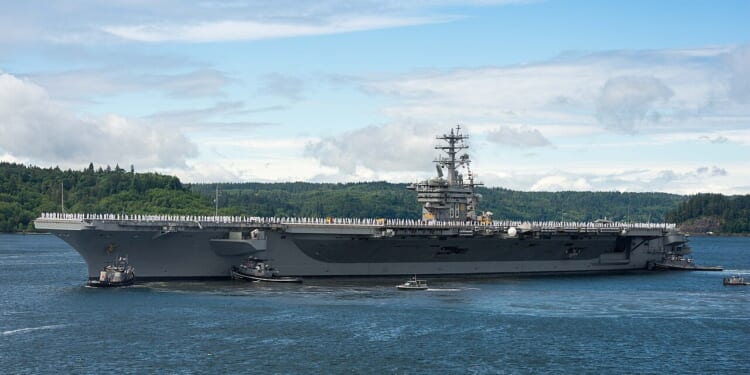The USS Nimitz’ upcoming retirement will leave the United States short an aircraft carrier until the new USS John F. Kennedy replaces it—now scheduled for 2027.
For the first time in more than two years—apart from very brief periods in the interim—the United States Navy has no aircraft carriers operating in the Middle East. After the Hamas terrorist attack in southern Israel on October 7, 2023 ignited the largest conflict in the region in decades, Washington has rotated several carrier strike groups (CSG) to the Red Sea, Gulf of Aden, and the Persian Gulf to stop an escalation and to deter Iran and its proxies.
Last week, with little fanfare, the USS Nimitz (CVN-68) departed the Middle East. The oldest nuclear-powered supercarrier in service transited the Singapore Strait on Friday, and is now operating in the South China Sea.
Two US Carrier Groups Are Now in the Western Pacific
During the past two years, the US Navy had seen overlapping CSG deployments to the Middle East, which left the Indo-Pacific region without any carriers. As of this month, there were briefly two CSGs in the Western Pacific for the first in years as USS George Washington (CVN-73) was conducting “routine operations” before heading to her home port of Yokosuka, Japan.
CVN-73 returned to the Yokosuka Naval Base at the end of November 2024, after completing her mid-life Refueling and Complex Overhaul (RCOH) in 2023. Due to delays, brought on in part by supply chain shortages following the pandemic, the RCOH lasted 2,117 days—almost as long as it took to build the ship in the first place.
USS Nimitz is now on what is almost certainly her final deployment.
The carrier departed from San Diego in March, and was ordered to the Middle East in June. It is unclear how much longer the Nimitz CSG will operate in the South China Sea, but USNI News reported that President Donald Trump will be in the region later this month, visiting “Malaysia on Oct. 26 to attend the Association of Southeast Asian Nations (ASEAN) summit.”
The Pentagon may want the CSG to be present during that visit, after which USS Nimitz is likely to return to the West Coast, before a scheduled homeport change next April to Norfolk, Virginia. That is when the oldest operational nuclear-powered carrier will begin her long deactivation process.
The US Navy Will Be Down a Carrier for a While
The United States Navy has been spread thin in deploying its high-profile flattops to hotspots around the globe, and the problem will further be complicated by the imminent retiring of USS Nimitz, as her replacement, the future Gerald R. Ford-class supercarrier USS John F. Kennedy (CVN-79), is behind schedule.
The JFK was supposed to be delivered to the US Navy this past July, but the handover was pushed back to March 2027. The delay, which was attributed to issues with the Advanced Arresting Gear and Advanced Weapons Elevator, two critical systems on the warship, will result in just 10 carriers being in service.
Even that number is still an overestimate, as the USS John C. Stennis (CVN-74) has yet to complete her RCOH at Norfolk and won’t be available until at least October 2026. At the same time, the next Nimitz-class carrier in line for the process, USS Harry S. Truman (CVN-75), is also in Norfolk to prepare for the RCOH, which is expected to begin next year. That carrier suffered damage during her last deployment to the Middle East, when she collided with a merchant ship in the Mediterranean Sea, but the US Navy opted to wait until the previously scheduled mid-life maintenance period to carry out the full repairs. At an event attended by Trump earlier this month, a massive banner was placed over the bulkhead to hide the damage.
The USS Gerald R. Ford Is the Newest Carrier in the Mediterranean
As the oldest operational nuclear-powered carrier remains in the South China Sea, the newest supercarrier, USS Gerald R. Ford (CVN-78) was set to arrive in Split, Croatia, on Monday for a scheduled port visit. It would be CVN-78’s second visit to the city, following a previous port call in 2023.
There has been speculation that USS Gerald R. Ford would head to the eastern Mediterranean, the same waters she was deployed to two years ago following the Hamas terrorist attacks, or perhaps even to the Middle East. Whether the carrier lingers in the region may depend on whether the fragile peace, brokered by US officials, holds. If not, and fighting resumes, CVN-78 may see a repeat from two years ago and have her deployment extended to deter escalation. It is a reminder that the US needs to deal with multiple hotspots around the globe—and has only so many carriers to deploy.
About the Author: Peter Suciu
Peter Suciu has contributed over 3,200 published pieces to more than four dozen magazines and websites over a 30-year career in journalism. He regularly writes about military hardware, firearms history, cybersecurity, politics, and international affairs. Peter is also a contributing writer for Forbes and Clearance Jobs. He is based in Michigan. You can follow him on Twitter: @PeterSuciu. You can email the author: [email protected].
Image: Wikimedia Commons.

















